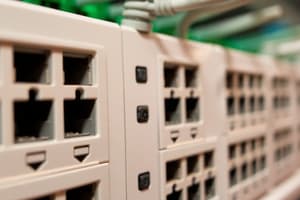Podcast
Questions and Answers
What must occur again after an entry has been removed from the ARP table?
What must occur again after an entry has been removed from the ARP table?
- Send an ARP reply
- Initiate a TCP handshake
- Send an ARP request (correct)
- Establish a UDP connection
What is a potential security risk associated with the ARP process?
What is a potential security risk associated with the ARP process?
- UDP flooding
- IP hijacking
- ARP spoofing (correct)
- DNS poisoning
Which ICMPv6 message is used for address resolution in the Neighbor Discovery protocol?
Which ICMPv6 message is used for address resolution in the Neighbor Discovery protocol?
- Router Advertisement
- Router Solicitation
- Redirect Message
- Neighbor Advertisement (correct)
What mechanism does enterprise-grade switches use to mitigate ARP attacks?
What mechanism does enterprise-grade switches use to mitigate ARP attacks?
Which message is NOT part of the five ICMPv6 messages used in Neighbor Discovery?
Which message is NOT part of the five ICMPv6 messages used in Neighbor Discovery?
What service does the redirect message in ICMPv6 Neighbor Discovery provide?
What service does the redirect message in ICMPv6 Neighbor Discovery provide?
What could occur if many devices are powered up simultaneously on a network?
What could occur if many devices are powered up simultaneously on a network?
What happens after a device sends an ARP request?
What happens after a device sends an ARP request?
What is a characteristic of the ARP reply?
What is a characteristic of the ARP reply?
What is ARP spoofing primarily used for?
What is ARP spoofing primarily used for?
Which ICMPv6 message is NOT used by Neighbor Discovery?
Which ICMPv6 message is NOT used by Neighbor Discovery?
Which of the following services does the Neighbor Discovery protocol provide for IPv6?
Which of the following services does the Neighbor Discovery protocol provide for IPv6?
Which factor determines the removal of ARP table entries?
Which factor determines the removal of ARP table entries?
What do IPv6 devices use to resolve MAC addresses instead of ARP?
What do IPv6 devices use to resolve MAC addresses instead of ARP?
What is a consequence of broadcasting an ARP request on a local network?
What is a consequence of broadcasting an ARP request on a local network?
Which ICMPv6 message is responsible for soliciting router information?
Which ICMPv6 message is responsible for soliciting router information?
What is the purpose of the ARP type field set to 0x806?
What is the purpose of the ARP type field set to 0x806?
What happens to packets if no device responds to an ARP request?
What happens to packets if no device responds to an ARP request?
What is a characteristic of static ARP entries?
What is a characteristic of static ARP entries?
Which message types does ICMPv6 Neighbor Discovery rely on?
Which message types does ICMPv6 Neighbor Discovery rely on?
When a source device needs to send a frame to an IPv4 address on another network, what is used?
When a source device needs to send a frame to an IPv4 address on another network, what is used?
What is one of the main risks associated with ARP spoofing?
What is one of the main risks associated with ARP spoofing?
Why is dynamic ARP inspection recommended in networks?
Why is dynamic ARP inspection recommended in networks?
How frequently does the ARP cache timer remove inactive entries in a device?
How frequently does the ARP cache timer remove inactive entries in a device?
What initial step does a host take when creating a packet for a destination IP address?
What initial step does a host take when creating a packet for a destination IP address?
Flashcards
What is ARP?
What is ARP?
ARP is a protocol used to map IPv4 addresses to MAC addresses.
What is an ARP table used for?
What is an ARP table used for?
Devices use ARP tables to store mappings between IPv4 addresses and MAC addresses.
How is an ARP table updated?
How is an ARP table updated?
ARP tables are updated when a device receives a packet from a new device, or when an entry expires.
What happens when a device wants to send a packet?
What happens when a device wants to send a packet?
Signup and view all the flashcards
What happens if the MAC address isn't found in the ARP table?
What happens if the MAC address isn't found in the ARP table?
Signup and view all the flashcards
What is an ARP request?
What is an ARP request?
Signup and view all the flashcards
How are ARP requests responded to?
How are ARP requests responded to?
Signup and view all the flashcards
What happens after the sending device receives the ARP reply?
What happens after the sending device receives the ARP reply?
Signup and view all the flashcards
What happens if no device responds to an ARP request?
What happens if no device responds to an ARP request?
Signup and view all the flashcards
What is ARP poisoning?
What is ARP poisoning?
Signup and view all the flashcards
How does ARP poisoning work?
How does ARP poisoning work?
Signup and view all the flashcards
How does IPv6 handle address resolution?
How does IPv6 handle address resolution?
Signup and view all the flashcards
How does ND work?
How does ND work?
Signup and view all the flashcards
What services does ND provide?
What services does ND provide?
Signup and view all the flashcards
What are the types of ICMPv6 messages used in ND?
What are the types of ICMPv6 messages used in ND?
Signup and view all the flashcards
What are Neighbor Solicitation and Neighbor Advertisement messages for?
What are Neighbor Solicitation and Neighbor Advertisement messages for?
Signup and view all the flashcards
What are Router Solicitation and Router Advertisement messages for?
What are Router Solicitation and Router Advertisement messages for?
Signup and view all the flashcards
What is the Redirect message for?
What is the Redirect message for?
Signup and view all the flashcards
How does ND request a MAC address?
How does ND request a MAC address?
Signup and view all the flashcards
How does ND respond to Neighbor Solicitation messages?
How does ND respond to Neighbor Solicitation messages?
Signup and view all the flashcards
How does ND improve security?
How does ND improve security?
Signup and view all the flashcards
Why is ND important?
Why is ND important?
Signup and view all the flashcards
Study Notes
ARP
- ARP is essential for mapping IPv4 addresses to MAC addresses
- Devices use ARP tables to store mappings of IPv4 addresses and corresponding MAC addresses.
- An ARP table entry has a timestamp and is removed if no traffic is received from the device before the timestamp expires.
- When a device needs to send a packet, it checks its ARP table for the destination IPv4 address and corresponding MAC address.
- If the address is in the ARP table, it uses the MAC address to create a frame.
- Otherwise, the sending device sends an ARP request, a broadcast frame, to find the MAC address associated with the destination IPv4 address.
- Devices that have the same target IPv4 address will respond with the matching MAC address.
- The reply is sent as a unicast frame to the device that sent the request.
- The device adds the mapping to its ARP table and can now send a frame to the destination.
- If no device responds to the ARP request, the packet is dropped.
- An ARP request is sent when the sender wants to determine the MAC address associated with an IPv4 address but doesn't have this mapping in its ARP table.
- Both ARP requests and replies are encapsulated in Ethernet frames—no IPv4 headers are used.
ARP Poisoning Attacks
- ARP poisoning attacks target the ARP table.
- An attacker can send a forged ARP reply that contains its MAC address rather than the legitimate device's MAC address, causing the receiving device to map the target IPv4 address to the attacker's MAC address.
IPv6 Neighbor Discovery Protocol
- IPv6 uses the Neighbor Discovery protocol (ND) to resolve IPv6 addresses to MAC addresses.
- ND is similar to ARP but uses ICMPv6 messages.
- It provides services like address resolution, router discovery, and redirection.
- ND uses five types of ICMPv6 messages: Neighbor Solicitation, Neighbor Advertisement, Router Solicitation, Router Advertisement, and Redirect.
- Neighbor Solicitation and Neighbor Advertisement messages are used for device-to-device communication.
- Router Solicitation and Router Advertisement messages are used for device-to-router communication.
- The Redirect message is used for route optimization.
Studying That Suits You
Use AI to generate personalized quizzes and flashcards to suit your learning preferences.




